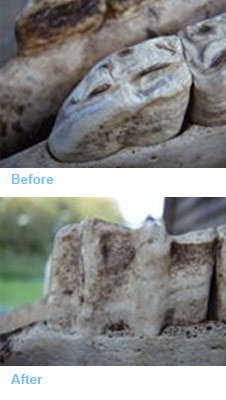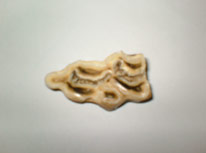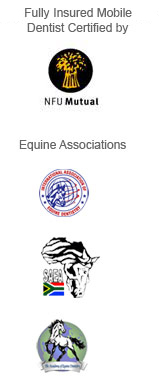Wolf teeth, bit seats, retained caps, calculus (tartar)
WOLF TEETH
The majority of wolf teeth are likely to cause problems and will reduce a horse's performance. The wolf teeth are the first premolars, normally only apparent in the upper jaw, but they can sometimes occur in the lower jaw. They are present at birth and can erupt at any time from a yearling onwards, and can vary in size from 1mm to 1cm in length. They can be up to 2cm in front of the second premolar, but more often are adjacent to it. They can be of particular annoyance to the horse when they are on the inside and close to the front of the second premolar.
Many wolf teeth are missed because they are very small, the same colour as the premolar and are impacted against the inside of the premolar which makes them difficult to see. Regrettably, people who are not trained sometimes attempt to remove wolf teeth, resulting in roots being left behind. The gum then grows over the root, causing the same effect as a small wolf tooth. Under these circumstances the veterinarian will x-ray the horse's jaw to determine if a root is present or not.

Bit seats are produced by:
- Optimising the three-point balance
- Removing wolf teeth
- Fashioning the second premolars.
BIT SEATS
A bit seat is produced so that the bit will fit comfortably in the horse's mouth whilst "three-point balance" is maintained. This will enable the horse to go forward in self-carriage with no restrictions imposed by the dental arcade. If the horse is uncomfortable in its mouth it may hold its head abnormally on its neck. This, in turn, will make the horse stiff through the back, may well altering its gait, reducing athletic performance and eventually cause lameness.
Many wolf teeth are missed because they are very small, the same colour as the premolar and are impacted against the inside of the premolar which makes them difficult to see. Regrettably, people who are not trained sometimes attempt to remove wolf teeth, resulting in roots being left behind. The gum then grows over the root, causing the same effect as a small wolf tooth. Under these circumstances the veterinarian will x-ray the horse's jaw to determine if a root is present or not.
If this abnormality of head carriage is continued for any length of time the musculature of the horse's neck, trunk and limbs will re-adjust and no longer be symmetrical between one side of the body and the other. This is the start of a vicious circle of a one-sided and possibly lame horse.

RETAINED CAPS
This is a cap. Caps are deciduous teeth, often called baby teeth. A retained cap is a cap that is still present after the appropriate time of shedding. Retained caps prevent normal growth and wear of the underlying teeth. This one is taken from a 2 to 3 year old Clydesdale. It was on one of the front molars and measures about 45mm (a big tooth!).
.jpg)
CALCULUS
Calculus (tartar) is a collection of organic and inorganic materials that can accumulate on the surface of the teeth, most often the canines. Calculus can cause inflammation of the gingival but can be easily removed.

